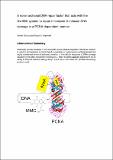Files in this item
A novel archaeal DNA repair factor that acts with the UvrABC system to repair mitomycin C-induced DNA damage in a PCNA-dependent manner
Item metadata
| dc.contributor.author | Giroux, Xavier | |
| dc.contributor.author | MacNeill, Stuart | |
| dc.date.accessioned | 2016-09-04T23:33:10Z | |
| dc.date.available | 2016-09-04T23:33:10Z | |
| dc.date.issued | 2015-12-22 | |
| dc.identifier | 214045682 | |
| dc.identifier | c4b5df8d-e195-405c-8446-cbcf1eedc2f3 | |
| dc.identifier | 84955179044 | |
| dc.identifier | 000369157900001 | |
| dc.identifier.citation | Giroux , X & MacNeill , S 2015 , ' A novel archaeal DNA repair factor that acts with the UvrABC system to repair mitomycin C-induced DNA damage in a PCNA-dependent manner ' , Molecular Microbiology , vol. 99 , no. 1 , pp. 1-14 . https://doi.org/10.1111/mmi.13210 | en |
| dc.identifier.issn | 0950-382X | |
| dc.identifier.other | ORCID: /0000-0002-0555-0007/work/39107857 | |
| dc.identifier.uri | https://hdl.handle.net/10023/9424 | |
| dc.description | This work was supported by the USAF Office of Scientific Research under award number FA9550-10-1-0421. | en |
| dc.description.abstract | The sliding clamp PCNA plays a vital role in a number of DNA repair pathways in eukaryotes and archaea by acting as a stable platform onto which other essential protein factors assemble. Many of these proteins interact with PCNA via a short peptide sequence known as a PIP (PCNA interacting protein) motif. Here we describe the identification and functional analysis of a novel PCNA interacting protein NreA that is conserved in the archaea and which has a PIP motif at its C-terminus. Using the genetically tractable euryarchaeon Haloferax volcanii as a model system, we show that the NreA protein is not required for cell viability but that loss of NreA (or replacement of the wild-type protein with a truncated version lacking the C-terminal PIP motif) results in an increased sensitivity to the DNA damaging agent mitomycin C (MMC) that correlates with delayed repair of MMC-induced chromosomal DNA damage monitored by pulsed-field gel electrophoresis (PFGE). Genetic epistasis analysis in Hfx. volcanii suggests that NreA works together with the UvrABC proteins in repairing DNA damage resulting from exposure to MMC. The wide distribution of NreA family members implies an important role for the protein in DNA damage repair in all archaeal lineages. | |
| dc.format.extent | 3240834 | |
| dc.language.iso | eng | |
| dc.relation.ispartof | Molecular Microbiology | en |
| dc.rights | © 2015 John Wiley & Sons Ltd. This work is made available online in accordance with the publisher’s policies. This is the author created, accepted version manuscript following peer review and may differ slightly from the final published version. The final published version of this work is available at: https://dx.doi.org/10.1111/mmi.13210. This article may be used for non-commercial purposes in accordance with Wiley Terms and Conditions for Self-Archiving (http://olabout.wiley.com/WileyCDA/Section/id-820227.html#terms) | en |
| dc.subject | DNA repair | en |
| dc.subject | Sliding clamp | en |
| dc.subject | Double-strand breaks | en |
| dc.subject | PCNA | en |
| dc.subject | Archaea | en |
| dc.subject | QR Microbiology | en |
| dc.subject | BDC | en |
| dc.subject.lcc | QR | en |
| dc.title | A novel archaeal DNA repair factor that acts with the UvrABC system to repair mitomycin C-induced DNA damage in a PCNA-dependent manner | en |
| dc.type | Journal article | en |
| dc.contributor.institution | University of St Andrews.Biomedical Sciences Research Complex | en |
| dc.contributor.institution | University of St Andrews.School of Biology | en |
| dc.identifier.doi | 10.1111/mmi.13210 | |
| dc.description.status | Peer reviewed | en |
| dc.date.embargoedUntil | 2016-09-04 |
This item appears in the following Collection(s)
Items in the St Andrews Research Repository are protected by copyright, with all rights reserved, unless otherwise indicated.

